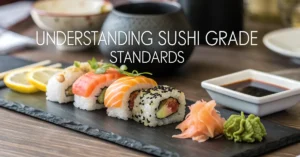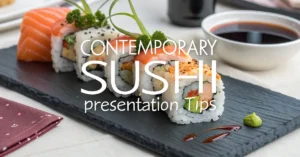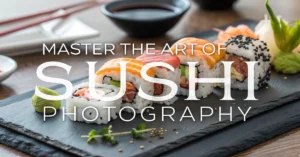Imagine biting into a piece of sushi. The cool, vinegared rice gives way to the delicate texture of raw fish, maybe a touch of wasabi tingles in your nose, and then… a wave of complex, savory, and maybe even sweet flavors washes over your palate. Sushi isn’t just food; it’s an experience.
But how do you truly experience sushi? It’s more than just knowing what you like. Learning the art of sushi tasting means developing your palate to discern the subtle nuances that distinguish great sushi from the merely good. It’s about understanding the ingredients, techniques, and traditions that go into each bite.
This article will help you become a more informed and appreciative sushi eater. We’ll explore the key elements of sushi, teach you how to evaluate them, and provide practical tips for expanding your sushi tasting horizons.
Understanding the Elements of Sushi Tasting
To truly appreciate sushi, you need to understand its core components. Each element plays a vital role in the overall experience.
The Rice: Shari (舎利)
Rice is the foundation of sushi. It’s not just any rice; it’s shari, specially prepared short-grain Japanese rice seasoned with vinegar, sugar, and salt.
- Texture: The ideal shari should be slightly sticky, allowing it to clump together without being mushy. Each grain should be distinct and retain a slight firmness.
- Flavor: The vinegar seasoning should be balanced, providing a subtle tanginess that complements the fish without overpowering it. Sweetness should be present but restrained.
- Temperature: Shari is typically served at body temperature or slightly warmer. This allows the flavors to fully develop and prevents the fish from becoming too cold.
The Fish: Neta (ネタ)
The fish, or neta, is the star of many sushi pieces. Its quality and freshness are paramount.
- Freshness: The fish should be glistening, firm, and free of any fishy odor. The color should be vibrant and characteristic of the specific fish.
- Texture: The texture varies depending on the fish. Some, like tuna, should be smooth and buttery, while others, like snapper, should be firmer and have a slight chew.
- Flavor: Each type of fish has a unique flavor profile, ranging from the rich, oily taste of salmon to the mild, delicate flavor of sea bream.
Wasabi (山葵)
Wasabi is a pungent Japanese horseradish that adds a spicy kick to sushi.
- Flavor: Real wasabi has a complex flavor that is more than just spicy. It has a subtle sweetness and a vegetal aroma. Many restaurants serve imitation wasabi made from horseradish, mustard, and green food coloring, which lacks the depth of flavor of the real thing.
- Quantity: A small amount of wasabi is typically placed between the fish and the rice. The amount should be adjusted to your preference, but it’s best to start small, as wasabi can be quite potent.
Ginger: Gari (ガリ)
Gari is thinly sliced, pickled ginger that is served as a palate cleanser between bites of sushi.
- Flavor: Gari has a sweet, sour, and slightly spicy flavor that helps to refresh the palate and prepare it for the next piece of sushi.
- Texture: The ginger should be crisp and slightly chewy.
Soy Sauce: Shoyu (醤油)
Shoyu is soy sauce, a fermented sauce made from soybeans, wheat, salt, and water.
- Flavor: There are different types of shoyu, each with a unique flavor profile. Koikuchi shoyu is the most common type, with a balanced flavor. Usukuchi shoyu is lighter in color and saltier. Tamari is a gluten-free soy sauce made without wheat.
- Quantity: Use soy sauce sparingly. The goal is to enhance the flavor of the sushi, not to mask it. Dip the neta lightly into the shoyu, avoiding soaking the rice.
Developing Your Sushi Palate: A Step-by-Step Guide
Now that you understand the elements of sushi, let’s discuss how to develop your palate and learn to appreciate the nuances of each bite.
Start with the Basics
Begin with common types of sushi that are readily available and have relatively mild flavors.
- Salmon (Sake): Salmon is a good starting point due to its rich, buttery flavor and tender texture.
- Tuna (Maguro): Tuna has a more pronounced flavor than salmon but is still relatively mild.
- Yellowtail (Hamachi): Yellowtail has a slightly sweet and nutty flavor.
Focus on Freshness
Freshness is the most important factor in sushi quality. Seek out reputable sushi restaurants that prioritize fresh, high-quality ingredients.
- Look for glistening fish: The neta should be shiny and translucent, not dull or opaque.
- Smell the fish: Fresh fish should have a clean, sea-like aroma, not a fishy odor.
- Ask the sushi chef: Don’t be afraid to ask the chef about the origin and freshness of the fish.
Pay Attention to Texture
Texture plays a vital role in the overall sushi experience. Different types of fish have distinct textures.
- Chewy: Squid, octopus, and some types of shellfish have a firm, chewy texture.
- Firm: Snapper, sea bream, and other white fish have a firmer texture.
- Tender: Tuna, salmon, and yellowtail have a more tender texture.
- Buttery: Some types of tuna, like otoro (fatty tuna), have a rich, buttery texture that melts in your mouth.
Explore Different Flavors
Once you’re comfortable with the basics, start exploring different types of fish and preparations.
- White Fish (Shiromi): Explore different types of white fish like snapper (tai), sea bream (madai), and flounder (hirame). These fish have delicate flavors that can be enhanced with different seasonings.
- Oily Fish (Hikari-mono): Try oily fish like mackerel (saba), sardine (iwashi), and herring (nishin). These fish have a richer, more intense flavor.
- Shellfish (Kaibashira): Experiment with different types of shellfish like scallop (hotate), clam (torigai), and ark shell (akagai). These have unique flavors and textures.
- Roe (Ikura, Uni): Discover the distinctive flavors of fish roe, such as salmon roe (ikura) and sea urchin (uni). These are acquired tastes, but many sushi enthusiasts find them to be delicacies.
- Vegetarian (Kappa Maki, Avocado Roll): Do not forget to try other vegetarian rolls. The best option to start is with the cucumber roll (kappa maki) and avocado roll. They can be prepared with sesame seeds as well.
Seasoning and Sauces
The art of seasoning goes beyond just soy sauce. Many sushi chefs use a variety of sauces and condiments to enhance the flavor of their sushi.
- Ponzu: A citrus-based sauce that is often served with white fish.
- Nikiri: A sweetened soy sauce that is brushed onto the fish by the sushi chef.
- Yuzu Kosho: A fermented chili paste with yuzu citrus, which adds a spicy and aromatic flavor to the sushi.
- Sea Salt: Many sushi chefs use sea salt to season the fish, enhancing its natural flavor.
Mindful Eating: Focus on the Sensory Experience
Pay attention to all of your senses when tasting sushi.
- Sight: Observe the appearance of the sushi. Notice the colors, textures, and shapes.
- Smell: Inhale the aroma of the sushi. What scents do you detect?
- Taste: Focus on the flavors as you chew. How do the different elements interact?
- Touch: Pay attention to the texture of the sushi in your mouth.
Palate Cleansing Techniques
Cleanse your palate between bites to fully appreciate the flavors of each piece of sushi.
- Gari: The traditional palate cleanser.
- Water: A sip of water can help to refresh your palate.
- Green Tea: A cup of green tea can also help to cleanse your palate.
Take Notes
Keep a journal to record your sushi tasting experiences. Note the types of sushi you tried, the flavors you detected, and your overall impressions. This will help you track your progress and identify your preferences.
Advanced Sushi Tasting Techniques
Once you’ve mastered the basics, you can move on to more advanced sushi tasting techniques.
Identifying Subtle Flavors
Developing the ability to identify subtle flavors requires practice and focus.
- Close your eyes: Closing your eyes can help you to focus on your sense of taste.
- Chew slowly: Chewing slowly allows you to fully experience the flavors.
- Consider the aftertaste: The aftertaste can provide valuable clues about the quality and complexity of the sushi.
Evaluating Rice Quality
The quality of the shari is just as important as the quality of the fish.
- Check the texture: The rice should be slightly sticky but not mushy. Each grain should be distinct.
- Taste the seasoning: The vinegar seasoning should be balanced and not too acidic.
- Feel the temperature: The rice should be served at body temperature or slightly warmer.
Discerning Fish Origins
The origin of the fish can affect its flavor and texture.
- Ask the sushi chef: Ask the chef about the origin of the fish.
- Research different regions: Learn about the different regions where sushi fish are sourced.
- Taste different origins side-by-side: If possible, try fish from different origins side-by-side to compare their flavors.
Understanding Seasonal Variations
The flavor of sushi fish can vary depending on the season.
- Learn about seasonal fish: Research which fish are in season at different times of the year.
- Ask the sushi chef: Ask the chef what seasonal fish they are serving.
- Taste seasonal variations side-by-side: If possible, try fish from different seasons side-by-side to compare their flavors.
Appreciating the Chef’s Technique
The skill of the sushi chef can greatly impact the quality of the sushi.
- Observe the chef’s technique: Watch how the chef prepares the sushi. Notice their precision and attention to detail.
- Talk to the chef: If possible, talk to the chef about their philosophy and techniques.
- Trust the chef: Trust the chef’s expertise and be open to trying new things.
Sushi Tasting Etiquette
There are a few basic rules of etiquette to follow when sushi tasting.
- Use chopsticks properly: If you’re using chopsticks, hold them correctly and avoid using them to point or gesture.
- Don’t rub your chopsticks together: This is considered rude, as it implies that you don’t trust the quality of the chopsticks.
- Don’t mix wasabi into soy sauce: This is also considered rude, as it masks the flavor of the sushi.
- Eat sushi in one bite: If possible, eat each piece of sushi in one bite. This allows you to experience all of the flavors and textures at once.
- Thank the chef: Show your appreciation for the chef’s skill and effort.
The Best Sushi Tasting Experiences Around the World
For serious sushi tasting enthusiasts, seeking out exceptional sushi experiences can be a rewarding culinary journey. Here are some of the best places around the world to indulge in high-quality sushi:
Tokyo, Japan
Tokyo is the epicenter of sushi culture. Here are some notable spots:
- Sukiyabashi Jiro: Famously featured in the documentary “Jiro Dreams of Sushi,” this legendary restaurant is known for its traditional Edomae-style sushi. Reservations are extremely difficult to secure.
- Sushi Saito: This three-Michelin-starred restaurant offers an intimate and refined sushi experience.
- Sushi Sho Masa: Renowned for its innovative and creative sushi preparations.
New York City, USA
New York City boasts a vibrant sushi scene with many high-end options.
- Masa: One of the most expensive and exclusive sushi restaurants in the world, Masa offers an omakase experience that showcases the finest ingredients.
- Sushi Nakazawa: Helmed by a former apprentice of Jiro Ono, Sushi Nakazawa offers high-quality sushi at a slightly more accessible price point.
- Shuko: Known for its Edomae-style sushi and modern tasting menus.
Los Angeles, USA
Los Angeles’s sushi scene is diverse and innovative.
- Sushi Gen: A long-standing favorite known for its fresh fish and traditional preparations.
- Q Sushi: Offers a refined omakase experience with a focus on seasonal ingredients.
- Nobu Malibu: Combines classic sushi with Peruvian-inspired flavors.
London, UK
London’s sushi scene is growing in popularity and quality.
- The Araki: A three-Michelin-starred restaurant offering an exclusive omakase experience.
- Sushi Tetsu: A small, family-run restaurant known for its high-quality sushi and intimate atmosphere.
- Dinings SW3: Offers a modern take on sushi with innovative flavor combinations.
Sushi Tasting: More Than Just Food
Developing your sushi tasting palate is an ongoing journey. The more you explore, the more you’ll discover the nuances and complexities of this culinary art form. Each experience, from the first tentative bite of salmon to the confident appreciation of uni, will expand your knowledge and appreciation for sushi. As you delve deeper, you’ll come to understand that sushi is more than just food; it’s a reflection of Japanese culture, tradition, and artistry. So, go forth, taste, and discover the world of sushi!



